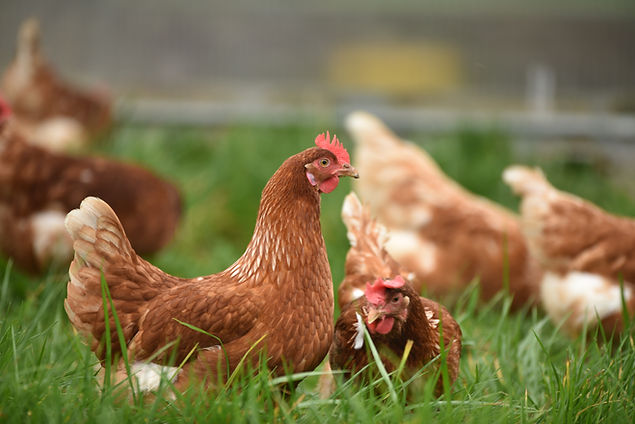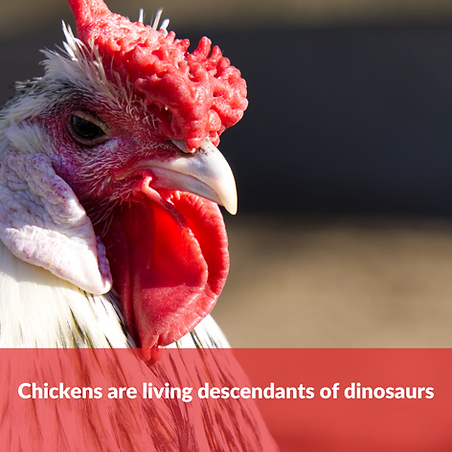
FARM ANIMAL COALITION
CHICKENS
Learn about chickens
When asked which is the most ubiquitous domesticated bird on the planet, chickens come to people’s minds. However, unfortunately, the image associated with chicken is usually as a commodity for human consumption rather than the complex creatures they are, which are capable of complex cognitive processes. The article on the behavior and cognitive skills of fowls and chickens by The Humane Society of the United States (2010) has shed light on many aspects surrounding this amazing bird often unacknowledged by the general public.
The chicken or Gallus gallus domesticus was domesticated over 8000 years ago, which took place in South-East Asia. Today’s chickens mainly originate from the red junglefowl. While the former are abundant in today’s society as a farmed animal, the latter are now in endangerment. However, there are several welfare issues pertaining to chicken mass production, such as feather pecking and cannibalism.
It is unfortunately not uncommon for people to view chickens or fowls as a food source, which can possibly be explained by our detachment towards their emotional and cognitive abilities.
Let's get scientific about chickens!
a) Ecology & diet
Although both can manage short-distance flight, chickens and jungle fowls generally make use of their feet to travel. Areas with dense vegetation are preferred as their ground cover, which is further enabled by their plumage’s colors that allow them to camouflage around the floor of the forest littered with red and brown leaves.
It has been noted that feral chickens may eat a multitude of plant matter, which expands their food choice within their habitats. They can even form symbiotic relationships with cattle. Chickens can sometimes eat stone, sand and fine grit, some of which are helpful to grind and crush food that comes through their gizzards during their digestive process.
b) Natural behaviors
On a fundamental level, domestic chickens retain some of the basic behaviors exhibited by their ancestors in the wild. Like jungle fowl, the foraging behavior is an important part of chickens. “Contra-free loading” refers to the preference of hens to find their own food instead of passively taking available food from a feeder.
The beak is an important part of a chicken’s body. This is used to touch, feel, pick up and maneuver objects, which means that the beak is indispensable for preening, nesting and as a defense tool. The tip of it is connected to receptors that enable touch, taste and feel of temperature.
It is remarkable that a chicken's brain weight equals the combined weight of their eyes. Their visual capabilities extend as far as ultraviolet range and cover 330 degrees.
A very important routine for chickens is grooming by means of preening, combing and fluffing their feathers. Dustbathing is also part of the practice, with the aim of getting rid of any excess oils.
c) Social behavior & nesting behavior
Chicken’s ancestors - the Red Jungle Fowl tend to live in a small and stable flock, which normally consists of one dominant male, and several females and subordinate males. The dominant male defends the territory, especially during breeding seasons to keep other roosters from their hens. The flock together participates in a variety of activities, including foraging, resting and preening. It is worth noting that both males and females establish pecking orders within their flock. Subordinate male chickens may make occasional entries and exits out of groups and are without female partners.
Before hens begin laying eggs, they leave the group and find an appropriate mate nest site. After laying eggs, for around 3 weeks, the hen sits on the nest throughout the day with the only exception of trips to find food and water. During this period, the hens can be signaled to turn her eggs or return to her nest by calls emitted from the growing chick embryos.
d) Development
The sensory sense of sight, hearing, smell and touch all commence to develop before the eggs hatch. External factors have an impact on the development of chicks despite the shell of the egg. Chicks can be described as precocial and adaptive, as evidenced by their ability to learn fundamental survival skills.
Imprinting occurs when chicks use their instincts to follow and learn from the first moving object they come to see, which in a natural environment is normally their mother. Pecking precision among little chicks develops over the course of their first few weeks. Their mother instructs her chicks to eat edible food by calling and pecking at the ground.
Protectiveness towards her chicks is in the nature of the mother hens. If their defenses fail, the mother hen squawks to redirect attention from the predators away from her chicks. This is also evident in the brooding behavior, which can be initiated by both the little chicks or the hen. Aside from brooding to keep her chicks warm, the hen generally broods her chicks from unpleasant weather and shields them from signs of danger.
Social facilitation is a term that describes chicks copying the behavior of one another when playing. Around 8-10 after hatching, the chicks can then forage without their mother although they continue to stay close to the adult flock which they will join at around the point of 18 weeks post-hatching.
e) Communication and intelligence
Before the eggs hatch, communication has already begun. A distress call can be emitted from the embryos when it is cold, to which the hen responds by moving the egg in the nest. Communication does not only revolve around the hen and her chicks but also extends to nest mates who use their vocalizations to influence one another. It is noteworthy that the sounds of clicking and bill clapping made in the later stage of development are believed to facilitate synchronization in hatching. This means that all the chicks in the clutch will break free at around the same time.
Amazingly, researchers have found that chicks can exhibit various types of calls, with as high as 19 additional calls identified for adult fowl. Adult fowls have two distinctive alarm calls, one of aerial predators and the other for terrain-bound threats. Selectivity is also demonstrated among chickens. Young males only emit food calls to females but they will give alarm calls for both sexes. Another point to note is that males evaluate the dominance of other males by the rate and quality of their crow calls.
Regarding intelligence, studies have highlighted the impressive cognitive abilities of chickens. Domestic chickens display an amazing ability to learn socially and take advantage of the correct and incorrect responses from the experiences of their conspecifics. This is not a simple or fixed process but one dependent on the context and social identity of the one observing and the one demonstrating (Nicol, 2006). Newly hatched chicks have a basic grasp of numerical concepts. This was demonstrated in a 2007 study, in which chicks have a fundamental understanding of ordinality up to 10 (Rugani, Regolin & Vallortigara, 2007).
In 2002, it was found that chickens may possess a basic sense of time (Taylor et al, 2002). Further studies highlighted the ability to anticipate the future in chickens (Abeysinghe, Nicol, Hartnell & Wathes, 2005). Results from an Italian research pointed out that chickens can even form mental images and grasp that even if they can no longer see an object, that object still exists (Regolin et al, 1995).
Fun facts about chickens!









.png)
